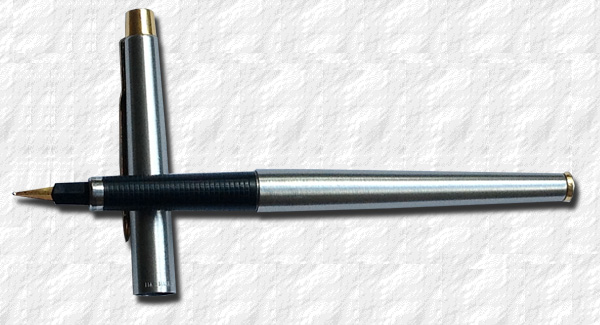
| parkerpens.net |
| PARKERCOLLECTOR.COM |
 Also: "International Classic" 1967-1994 |
||
| name of it’s own and there were no fountain pens produced in the International Classic line. It followed the design of the immensly popular fountain pen Parker 75, including the Sterling silver Cicelé and Vermeil Cicelé; gold plated sterling silver. The clip had a newly designed Parker Arrow clip, with the longitudinal arrow an integral part of the bottom of the ”feathers”, like an elongated Y. |
||
 |
Classic in Sterling silver Cicelé |
|
a design to become very popular on other models in the mid 1980’s.
|
|
Image © and courtesy of Erik Drijfhout |
Parker Classic GT fountain pen. |
 |
Flighter GT and Flighter CT ballpens. |
14k gold nib was replaced with a gold plated stainless steel nib. This was also the nib design on the Classic. The Classic was about 135 mm long when closed and 9.5 mm wide. It had a steel ring at the end of the section.
|
|
|
The Matte Black Classic |
|
According to Jim Mahmoulian the Classic surfaced again as a ballpoint and pencils in the 2001 catalogue. In 2003 it was gone again. This could however be discreapancies between the US and European markets. |
Read more about the Space pen at Lih Tah Wongs great site http://www.parker75.com
© 1995-2019 Tony Fischier and The Parker Pen Company®/Sanford Ecriture.
This page is in no way sponsored by or created by the Parker Pen Company®. All opinions, views, and thoughts expressed herein are expressly the authors, and in no way reflect the opinions, views, or thoughts of the Parker Pen Company®/Sanford Ecriture. All logos and/or images on these pages are © Copyright of Parker Pen Company®Sanford Ecritureunless otherwise stated and is reprinted by kind permission. If You feel that Your copyright has been violated please contact the WEBMASTER.
Everything on this website is copyrighted by law and can not be used without written permission from the author, Tony Fischier. You may however use the information as reference material and although it is forbidden to make digital copies or reproductions it may be physically printed for personal use, which does not include use on other web pages or in advertising. You may however quote parts of the content of this website, digitally or physically, providing that the source and author is clearly stated, together with the copyright information. In the US referred to as Fair use. If you use any information on this site, add a link.
Feel free to donate a small sum through Paypal to help this site to stay online. Acknowledgements.
Parkercollector.com in translated versions

